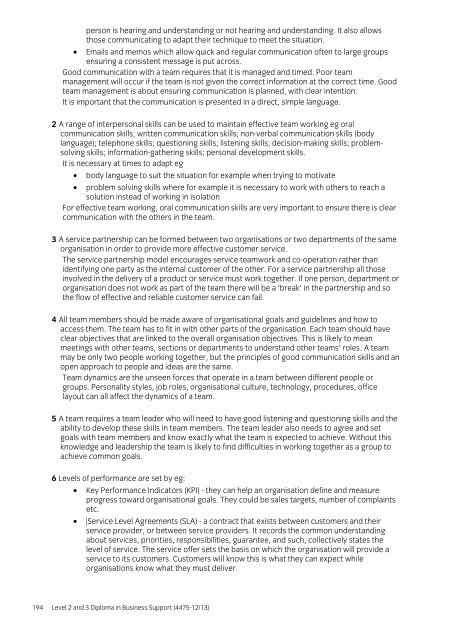Level 2 and 3 Diploma in Business Support (4475-12/13)
Level 2 and 3 Diploma in Business Support (4475-12/13)
Level 2 and 3 Diploma in Business Support (4475-12/13)
You also want an ePaper? Increase the reach of your titles
YUMPU automatically turns print PDFs into web optimized ePapers that Google loves.
person is hear<strong>in</strong>g <strong>and</strong> underst<strong>and</strong><strong>in</strong>g or not hear<strong>in</strong>g <strong>and</strong> underst<strong>and</strong><strong>in</strong>g. It also allows<br />
those communicat<strong>in</strong>g to adapt their technique to meet the situation.<br />
• Emails <strong>and</strong> memos which allow quick <strong>and</strong> regular communication often to large groups<br />
ensur<strong>in</strong>g a consistent message is put across.<br />
Good communication with a team requires that it is managed <strong>and</strong> timed. Poor team<br />
management will occur if the team is not given the correct <strong>in</strong>formation at the correct time. Good<br />
team management is about ensur<strong>in</strong>g communication is planned, with clear <strong>in</strong>tention.<br />
It is important that the communication is presented <strong>in</strong> a direct, simple language.<br />
2 A range of <strong>in</strong>terpersonal skills can be used to ma<strong>in</strong>ta<strong>in</strong> effective team work<strong>in</strong>g eg oral<br />
communication skills; written communication skills; non-verbal communication skills (body<br />
language); telephone skills; question<strong>in</strong>g skills; listen<strong>in</strong>g skills; decision-mak<strong>in</strong>g skills; problemsolv<strong>in</strong>g<br />
skills; <strong>in</strong>formation-gather<strong>in</strong>g skills; personal development skills.<br />
It is necessary at times to adapt eg<br />
• body language to suit the situation for example when try<strong>in</strong>g to motivate<br />
• problem solv<strong>in</strong>g skills where for example it is necessary to work with others to reach a<br />
solution <strong>in</strong>stead of work<strong>in</strong>g <strong>in</strong> isolation<br />
For effective team work<strong>in</strong>g, oral communication skills are very important to ensure there is clear<br />
communication with the others <strong>in</strong> the team.<br />
3 A service partnership can be formed between two organisations or two departments of the same<br />
organisation <strong>in</strong> order to provide more effective customer service.<br />
The service partnership model encourages service teamwork <strong>and</strong> co-operation rather than<br />
identify<strong>in</strong>g one party as the <strong>in</strong>ternal customer of the other. For a service partnership all those<br />
<strong>in</strong>volved <strong>in</strong> the delivery of a product or service must work together. If one person, department or<br />
organisation does not work as part of the team there will be a ‘break’ <strong>in</strong> the partnership <strong>and</strong> so<br />
the flow of effective <strong>and</strong> reliable customer service can fail.<br />
4 All team members should be made aware of organisational goals <strong>and</strong> guidel<strong>in</strong>es <strong>and</strong> how to<br />
access them. The team has to fit <strong>in</strong> with other parts of the organisation. Each team should have<br />
clear objectives that are l<strong>in</strong>ked to the overall organisation objectives. This is likely to mean<br />
meet<strong>in</strong>gs with other teams, sections or departments to underst<strong>and</strong> other teams’ roles. A team<br />
may be only two people work<strong>in</strong>g together, but the pr<strong>in</strong>ciples of good communication skills <strong>and</strong> an<br />
open approach to people <strong>and</strong> ideas are the same.<br />
Team dynamics are the unseen forces that operate <strong>in</strong> a team between different people or<br />
groups. Personality styles, job roles, organisational culture, technology, procedures, office<br />
layout can all affect the dynamics of a team.<br />
5 A team requires a team leader who will need to have good listen<strong>in</strong>g <strong>and</strong> question<strong>in</strong>g skills <strong>and</strong> the<br />
ability to develop these skills <strong>in</strong> team members. The team leader also needs to agree <strong>and</strong> set<br />
goals with team members <strong>and</strong> know exactly what the team is expected to achieve. Without this<br />
knowledge <strong>and</strong> leadership the team is likely to f<strong>in</strong>d difficulties <strong>in</strong> work<strong>in</strong>g together as a group to<br />
achieve common goals.<br />
6 <strong>Level</strong>s of performance are set by eg:<br />
• Key Performance Indicators (KPI) - they can help an organisation def<strong>in</strong>e <strong>and</strong> measure<br />
progress toward organisational goals. They could be sales targets, number of compla<strong>in</strong>ts<br />
etc.<br />
• |Service <strong>Level</strong> Agreements (SLA) - a contract that exists between customers <strong>and</strong> their<br />
service provider, or between service providers. It records the common underst<strong>and</strong><strong>in</strong>g<br />
about services, priorities, responsibilities, guarantee, <strong>and</strong> such, collectively states the<br />
level of service. The service offer sets the basis on which the organisation will provide a<br />
service to its customers. Customers will know this is what they can expect while<br />
organisations know what they must deliver.<br />
194 <strong>Level</strong> 2 <strong>and</strong> 3 <strong>Diploma</strong> <strong>in</strong> Bus<strong>in</strong>ess <strong>Support</strong> (<strong>4475</strong>-<strong>12</strong>/<strong>13</strong>)







